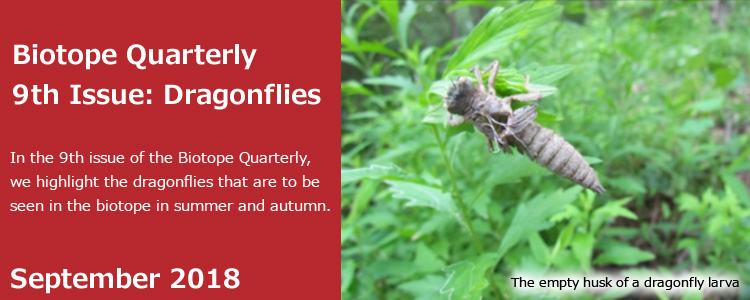
Dragonflies: a Yardstick of Biodiversity
The dragonfly lives in the water as a larva and on land as an adult. Its spawning location is widely varied: different species may spawn on water surfaces, on aquatic plants, in the mud, or in grasslands. Adult dragonflies may live on plains, hillsides or mountains, rivers, ponds, marshes (swamps), or wetlands, in paddy fields, or on the coast. The larval period also varies greatly from species to species, from one month (Usaka Tombo, e.g.) to several years (Onyangma, e.g.).
Also, both larvae and adults are carnivorous, and dragonflies need places where various creatures such as insects to eat and the plants that insects eat are to be found. In other words, the more individuals and species of dragonflies there are in a locale, the greater a diversity of plants and animals is found.
The Dragonflies of the Biotope (12 Species, in Alphabetical Order.)
There are many species in which the body color of the male changes dramatically as an adult, unlike other insects. The reason for the body color change is not well known, but it is one way of distinguishing dragonfly species. However, we are not dragonfly experts, and in the biotope there are also dragonflies besides those introduced here that we cannot conclusively identify.
- Autumn Darter
-
Family Libellulidae
Habitat: paddy fields, ponds, swamps, wetlands, etc.
In Japanese these are also called "red dragonflies." During the summer they live in mountainous area, and in fall they come down to the flatlands. Even in the biotope, we see them emerging around June and then again in the fall, but we do not see them much in summer.

- Asian Damselfly
-
Family Coenagrionidae
Habitat: Ponds with aquatic plants, swamps, wetlands, slow-flowing rivers
Compared with dragonflies, damselflies have thinner bodies. There are a great number of species, and it is hard to distinguish among them. The male Asian Damselfly has a light blue tail.

- Wandering Glider
-
Family Libellulidae
Habitat: open wetlands
The wandering glider is famous as a species that moves from the tropical zone to the north in the northern hemisphere and to the south in the southern hemisphere, moving over generations. The ones seen in Japan do not live in Japan all the time, but travel. Wandering gliders which reach cold climates cannot survive the winter or leave surviving descendants, yet new ones mysteriously continue to be born in tropical regions.

- Golden Flangetail
-
Family Gomphidae
Habitat: Low open ponds and swamps, in hilly terrain or on flat ground
Its tail has a small pointed appendage, and it is a special characteristic of the golden flangetail to move with each breath.

- Lesser Emperor
-
Family Aeshinidae
Habitat: Hillsides to low open ponds, swamps, slow-flowing rivers, artificial ponds, etc.
The lesser emperor flies fast and can keep flying for a long time. Because it often flies higher than other dragonflies, taking pictures of it is not easy!

- Sieboldius albardae
-
Family Gomphidae
Habitat: From midstream to downstream areas of rivers where there is woodland nearby
This dragonfly has no English common name. The pattern of the body looks a lot like the golden-ringed dragonfly, another species native to Asia, but it is not as large.

- Pseudothemis zonata
-
Family Libellulidae
Habitats: Ponds surrounded by trees, hills, slow-flowing rivers
The female has a yellow patch on her back. The male also has a yellow patch at first, but this turns white when the insect matures.
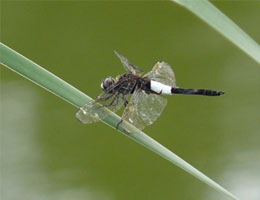
- White-tailed Skimmer
-
Family Libellulidae
Habitat: Ponds, swamps, wetlands, paddy fields, slow-flowing rivers, etc.
Mature males wipe a white powder like salt along their thoraxes. In the biotope, this is the most common dragonfly in the early summer season.
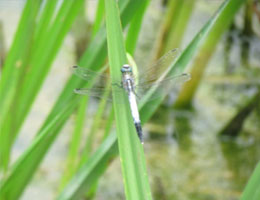
- Scarlet Skimmer
-
Family Libellulidae
Habitat: Low-lying open ponds, swamps, wetlands, etc. from hilly areas to the flat
Mature males of this species become more vivid red than so-called "red dragonflies," while females and young males are plain orange.

- Rhyothemis fuliginosa ("Butterfly Dragonfly")
-
Family Libellulidae
Habitats: Ponds with aquatic plants from flatland to hilly areas, swamps, streams, slow-flowing rivers
With its vivid wings it is easy to see how this dragonfly got its Japanese common name. In Gunma Prefecture, where our biotope is, it is designated as a near-threatened species. We only see it once every few years.
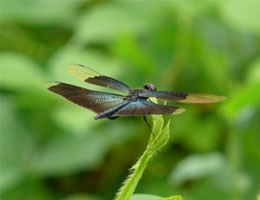
- Sympetrum darwinianum ("Red Dragonfly")
-
Family Libellulidae
Habitat: Ponds, swamps, wetlands, paddy fields, etc.
Again, it is easy to see why this species is known as "red dragonfly." You can see it in flatlands in summer.

- Atrocalopteryx atrata
-
Family Calopterygidae
Habitat: Rivers or irrigation canals with plentiful aquatic plants, from hilly terrain to flatlands.
This is a damselfly, not a true dragonfly. Its black wings are impressive. The blacks are more prominent in males than females. It lives in the dark woods for a while after hatching, and comes back to the waterside when mature. The biotope, where trees and ponds coexist, seems to be a suitable place for this species.
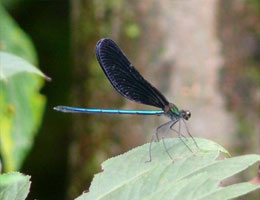
Reference material: Dragonflies of Japan, by 尾園 暁 and 川島 逸郎, 2012
Fuji Bakama Update
Our Fuji Bakama plants have flowered again this year!
There are only four known locations in Gunma Prefecture where the Fuji Bakama grows. When a partial review of the Gunma Prefecture Plant Redlist was carried out recently, the Fuji Bakama was reclassified from "endangered species IB class" to "endangered species IA class," which represents maximum danger of extinction.
In this biotope, we have been working for several years to improve the environment of our Fuji Bakama specimens. Originally we planted it on a sunny bank, but it ended up growing among reeds, on which it relies. Fuji Bakama cannot stand on its own and falls over if you remove the reeds or taller grasses that shelter it. Some say convincingly that it collapses to "seek the sunshine," but there is also the theory that it "lies down" in order to spread its seeds more widely.
There are many things that we do not yet know about the ideal Fuji Bakama environment, so our trial and error process is set to continue for a while.

